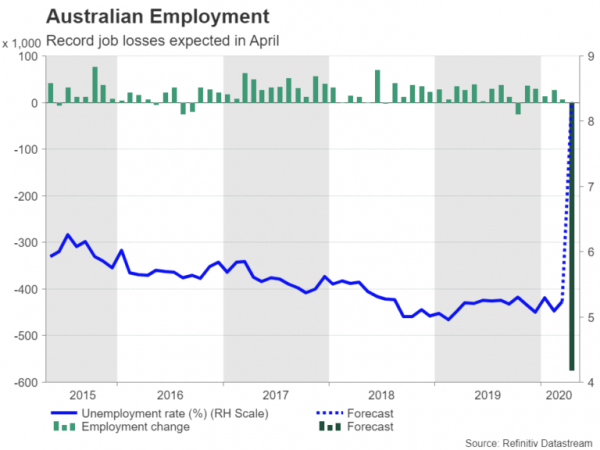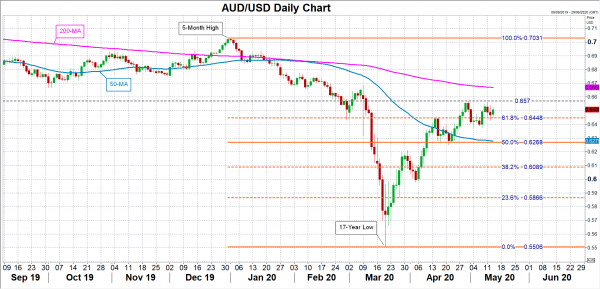Australia is among the few fortunate countries that can claim success in quickly containing the spread of the coronavirus. But on Thursday, the latest employment report, due at 1:30 GMT, will reveal what the cost of that success was on the labour market. The number of job seekers is expected to have soared in April. But with the country’s lockdown being slowly relaxed, the primary concern for aussie traders now is how fast the recovery will be.
Unemployment to jump to highest since 1997
After a surprise increase in employment in March, things are about to get ugly as 575,000 Australians are forecast to have lost their jobs in April. And this is likely to be just the start as the survey by the Australian Bureau of Statistics covers only the first half of month (which explains why the March figures were so positive). To add further perspective to the dire situation, the unemployment rate looks set to shoot up to levels not seen since mid-1997. Expectations are that the jobless rate jumped from March’s 5.2% to 8.3% in April.
Like many other countries affected by the COVID-19 outbreak, Australia has introduced a scheme to subsidize people’s wages to encourage employers to keep workers on during the crisis. It is estimated that more than 3 million employees were being supported by the government’s JobKeeper scheme at the end of April. But while that should help keep the jobless number down, it’s likely to come at a huge cost to the government, and that’s assuming there is an economic recovery in the second half of the year.
RBA forecasting slow recovery in jobs
The Reserve Bank of Australia is predicting the unemployment rate will hit 10% by June and fall only marginally to 9% towards the end of the year. The government is a little more optimistic when it comes to the prospect of the job market bouncing back after lockdown restrictions have been scaled back. But the disparity nevertheless highlights the risks to the outlook.
The RBA’s projections point to only a slow rebound in both private consumption and business investment, and this is likely to put a cap on how many jobs are instantly restored once the lockdowns are gradually eased. The job losses in Australia’s important tourism industry, in particular, are at most risk of becoming permanent as it could take several years for global travel to fully recover from the virus pandemic.
April data may not matter for RBA, and aussie
But as far as the April employment data is concerned, it is not expected to have a huge impact on RBA policy as policymakers will want to focus on post-lockdown figures to gauge the speed of the recovery and assess whether there’s a need for further monetary stimulus. Hence, the Australian dollar may just register a knee-jerk reaction to the jobs numbers as it continues to consolidate after rallying to a 7-week high on April 30.
Should the employment report make for grim reading, aussie/dollar may easily slip below immediate support at the 61.8% Fibonacci retracement of the January-March downtrend at 0.6448. A drop below this level would open the way for the 50-day moving average just above the 50% Fibonacci of 0.6268. However, if the jobs data isn’t as bad as anticipated, aussie/dollar may make another attempt for the 0.6570 level, which is proving to be a tough resistance barrier.














